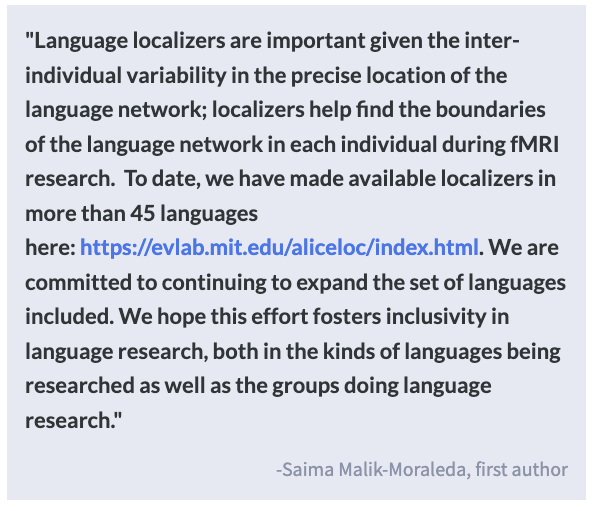Common Brain Network for Language Processing Across 45 Different Languages
Post by Elisa Guma
The takeaway
A common language network across 45 diverse languages was identified using functional magnetic resonance imaging. This network is comprised of frontal, temporal, and parietal brain regions lateralized to the left hemisphere.
What's the science?
Over 7,000 different languages, originating from over 100 common ancestral languages, are spoken around the world today. While there is great diversity in the complexity, sounds, lexical categories, and rules surrounding sentence structure, there may also be some universal language properties, such as the ability of language to allow for efficient communication. To understand whether there is a shared neural and cognitive architecture of human language, it is imperative that we study a variety of different languages. This week in Nature Neuroscience, Malik-Moraleda and colleagues sought to identify a core neural architecture associated with language using large-scale functional magnetic resonance imaging across native speakers of 45 different languages from 12 different language families.
How did they do it?
The authors’ first goal was to determine whether the core language network characterized in native English speakers is similar in native speakers of other languages. They adopted a ‘shallow’ sampling approach by testing a small number of speakers for each of the 45 different languages included in this study (1 male and 1 female where possible). Additionally, all speakers were fluent in English. The 45 languages came from 12 language families including Afro-Asiatic, Austro-Asiatic, Austronesian, Dravidian, Indo-European, Japonic, Koreanic, Atlantic-Congo, Sino-Tibetan, Turkic, Uralic, and Basque.
Each participant underwent functional magnetic resonance imaging while performing two different language tasks. In the first task, participants had to read sentences in English and nonword sentences. In a second task, they listened to a short passage from Alice in Wonderland translated into their native language. There were also two control conditions in which they listened to the same passage in an unfamiliar language, or they listened to non-discernible linguistic content (gibberish). Finally, to investigate whether brain regions that support language processing also show selectivity for language, the participants were asked to perform two non-language tasks, including a spatial working memory task and an arithmetic task.
What did they find?
Consistent with previous work, the authors found that high-level language processing areas were more active when participants read sentences relative to nonword sentences in English. These regions lie on the lateral surfaces of the left frontal, temporal, and parietal cortices. Furthermore, higher levels of neural activity were observed when participants heard the passage of Alice in Wonderland in their native language compared to when they heard a degraded language passage or a passage in a language they did not speak. The variability observed across speakers of different languages was similar to variability commonly seen among individuals for a single language. Finally, these brain regions were also significantly more active when participants were engaged in native-language conditions compared to the spatial working memory task or the arithmetic task, suggesting that language regions are indeed specific to language processing. Overall, effects were more pronounced in the left hemisphere than in the right.
What's the impact?
By leveraging native speakers of 45 different languages, the authors identified a common and broad, cross-linguistic language network. This left-lateralized network, comprised of fronto-temporo-parietal regions, was functionally selective for language processing across speakers of 45 different languages. This work furthers our understanding of the cognitive and neural basis of language processing and is the first to study these properties across such a wide variety of languages.


